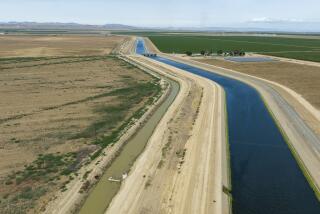Critical Point for the Delta
- Share via
The Sacramento-San Joaquin Delta is a marvel of our geography that remains a mystery to many Californians. The delta, nearly 400 miles north of Los Angeles, is formed by the confluence of the Sacramento and San Joaquin rivers, which drain the vast Central Valley, a watershed larger than Kentucky. The waters meander and mingle through a maze of sloughs, marshes and islands before ultimately flowing out to the Pacific through San Francisco Bay.
The 738,000-acre delta is a recreation wonderland rich in fish and wildlife. Houseboating is a popular delta vacation. Marinas line the sloughs. Duck clubs thrive. Since 1870, the natural marshland has been reclaimed and transformed into 57 islands--most of them unpopulated--through an 1,100-mile network of levees. With its rich peat soil, the delta became a lush farming region.
But the delta is far more than a geographical curiosity or vacation destination. The delta is the very heart of California’s vast water management system, the source of irrigation water for farms in the San Joaquin Valley and a critical provider of industrial and household water for all of Southern California.
Giant pumps suck massive amounts of water from the southern delta and into state and federal canals. The State Water Project aqueduct climbs over the Tehachapi Range to become a major source of supply for the Metropolitan Water District, which distributes water through 27 member agencies to 16 million people throughout Southern California.
But the delta is in trouble and has been almost since the day the pumps began moving water in the 1950s. The environmental damage is just now being understood by experts who are studying the impact on fish and wildlife, the riparian habitat and the fragile levees.
State and federal agencies are developing solutions through a cooperative venture known as the Cal-Fed process. Cal-Fed has reached a critical point. The experts are preparing to release a detailed environmental impact report on possible technical solutions to delta problems. The options are:
% Leave the waterways essentially unchanged.
% Alter existing channels to move water more efficiently to the pumps.
% Build an “isolated facility”--a pipeline or canal--to take fresh Sacramento River water directly to the pumps, bypassing the channels. Whatever the choice, farmers want more water storage. Some urban districts seem disposed toward a canal as the best way to guarantee high-quality water to their customers. Environmentalists generally oppose a canal because they fear any direct conduit would lead to more damage.
The early sparring bears a disturbing resemblance to the bitter north-south battle over a proposed Peripheral Canal around the delta, defeated in the 1982 election. But Cal-Fed involves much more than conveyance of water across the delta. This is a comprehensive 20-to-30-year program costing as much as $8 billion to restore and protect the environment, stabilize water supplies from the delta and improve water quality.
The entire effort is threatened if a new water war erupts prematurely over the report of the technical experts. This is just one step in a long, deliberative process that will, in the end, depend on achieving a political balance between all the major interests in the delta.
The key fact to remember now is that the ultimate goal of Cal-Fed is a healthy delta. Without that, there can be no winners.
More to Read
Sign up for Essential California
The most important California stories and recommendations in your inbox every morning.
You may occasionally receive promotional content from the Los Angeles Times.










